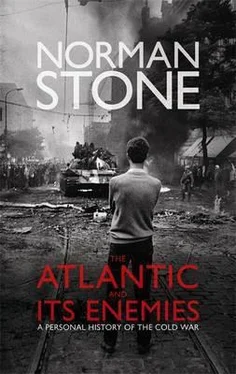America in a Turkish mirror made for a contrast with Chile. In Chile there was a general in charge, and there were no elections for ten years while Chicago economists sorted things out. Then she experienced the end of history. Turkey did not, although there was a brave try. There, the army did not want formal power: no Pinochet. It was happier with professors of Political Science, and wanted figureheads. Turhan Feyzioğlu had thought that he would be indispensable to the generals, as an old, reliable republican alternative to the wayward Ecevit. There, he was wrong: this was a military coup with a big difference. This time round, the generals had thought things through; Turkey was the front line of front-line countries; it would not do for it to be run on non-democratic lines; there would have to be a democracy, the only one for a considerable number of miles to the east, north and south. Democracy generally meant Demirel, whom the military did not want at any price. They got Özal instead. In his way, he was a sort of South Korean politician, and this was an era when South Koreas shot into worldwide prominence, more interesting and productive than assorted European Legolands where a large part of the gross domestic product consisted of divorced men’s taxes, paying for other men’s divorced wives to have jobs as divorce counsellors, all paying VAT. He did not believe in the State, or at any rate not the Republican, Atatürk state. Özal was the IMF’s trusted man: he had served at the World Bank for two years, and worked closely with the Sabanci dynasty, where he understood directly the virtues of private enterprise (as distinct from state-dependent enterprise, the Sabancis being, on the whole, less dependent than other great enterprises) and the German government helped. As director of the employers’ union, he had been quite tough. Demirel had been his original patron, though as Özal rose the relationship became tense (in 1990 Özal put up a memorial to Menderes, and Demirel, who regarded himself as rather more successful, was put out; he brought back the bones of Enver Pasha from Kirghizia as a come-back, the Democrats being children of the Young Turks).
Özal won in 1983 because he had outmanoeuvred the generals. They took the blame for the 24 January measures, and the Özal party, ANAP, counted as opposition. His reign was very Second Empire, even to the point where, at its end, horizontales arrived from the Soviet Union in battalions (and caused such havoc among traditional religious marriages on the Black Sea coast that a law was passed against adultery: like the Atatürk hat law, it was a declaration of intent, much criticized by humourless people). Money showered, old quarters of Istanbul were bulldozed for motorways to take fancy motor cars, and there were always the tarikat connections to make hand wash hand in Anatolia (in Özal’s case, the Nakshibendi, who were quite open: his main Kurdish ally, Kâmran İnan, was one of their leaders, a Sheikh, with a Lausanne degree in law and a Swiss wife). Islam in Turkey was not at all dissimilar from Catholicism in Italy, and this had long, long origins. Even in mid-Byzantine times, Anna Comnena had divided the Anatolians into Greeks, barbarians and semi-barbarians, meaning the Turks. Özal was a very clever man, sitting on his exercise bike (it failed: he was huge) and zapping CNN, driving a BMW at absurd speeds, taking parades in a baseball cap and telling the generals to turn up to lunch. He was a far more interesting man than the wooden Pinochet, and moved his country forward in an extremely interesting direction. But he failed. The problem goes back to 1986, the return of inflation. Özal gave up, and was diverted, like Margaret Thatcher, into foreign policy, an entertainment not vouchsafed to Pinochet, who could get on with the job.
Özal’s government did remarkably well in the first period, with a cabinet largely made up of American doctorates and engineers (the chief Treasury minister, Kaya Erdem, clearly knew his business). Currency liberalization had to be pushed through the hostile bureaucracy; its style had been to present 13,000 pages, now reduced to fifteen; it retained valuable property — large offices, summer houses, shares, gold, etc. Inflation fell back — roughly to 30 per cent — as protection came down (only 200 items being banned for import; by 1988 thirty-three needed approval, and after 1984 only three were entirely prohibited). Tariffs, wharf charges, VAT had meant that the real rate of protection stood at around 60 per cent (c.i.f.) and it had often changed. Motor cars had incurred duty of 112 per cent in 1980, 145 per cent in 1986, 74 per cent 1989. Exporters’ tax rebates were accelerated, and after 1980 they were allowed to retain $40,000 and then more (earlier there had been compulsory clearing at the central bank, to pay for imports). The exchange rate itself was unified, as against the variable earlier rates, and income tax, hitherto the largest item on the revenue side, was cut from 40 to 25 per cent, and on companies to under 50 per cent, while VAT was raised at 10 per cent. Up to $3,000 could be bought per person, without restriction. Later, this was altogether freed. By 1987 income tax contributed only a quarter of income, indirect taxes one third. Parts of the country began to flourish, particularly the ultra-Western areas — Istanbul and the north-west, İzmir, some places on the south coast; there was a shift in trade towards Europe, and a growth of part-manufacture, particularly for Germany. By any index, Turkish prosperity was growing. One sign was the freedom to travel — people could now move more than once every three years, though a hundred-dollar tax remained until 1996.
However, there was much difficulty as regards the disciplines of monetarism: how could government expenditure be reduced? It was all very well to liberalize foreign trade and currency exchange: these things were vital. But what Pinochet had done in domestic matters was a different matter altogether, and here Özal was stuck; perhaps he even wanted to be stuck, because he had an excuse to channel state funds in the direction of his friends. Privatization might have been an answer, but in practice there were great problems — not least because the constitutional court kept striking down the proposals on the grounds that they were against the national interest. Public spending took a quarter of the GNP in 1980, a fifth in 1984, slightly more than that in 1987, and there was a constant deficit, 3-5 per cent of GNP, to which the State boards’ deficits might be added (6 per cent). The outcome was chronic inflation. Up to 1985 the lira had fallen steadily, in fact faster in dollar terms than in domestic prices. This was, overall, healthier than the alternative which set in after 1985, when Turkey joined efforts at managed exchange rates. After 1985 domestic prices rose faster than the dollar. More paper emerged from the Turkish printing press, and it could be freely exchanged for dollars, as insurance, at a crawling-peg rate. Time deposits could be held at will and switched, after very large interest rate gains, into dollars, and the upshot for anyone with savings was a 25 per cent tax-free annual dollar profit.
The technicality was that the dollar rose from 14 lire in 1975 to 47 in 1979, 76 in 1980, 163 in 1982, 225 in 1983, 522 in 1985, 1,422 in 1988 and 2,609 in 1990 (by March 2000 it had reached 600,000, and in 2003 1.6 million). The US price index rose from 56.6 per cent of the figure for 1985, reaching 95 per cent in 1981, after which there was stabilization (by 1990, 113). From 1985 to 1990 the Turkish price index rose from 100 to 769. In other words, the Turkish currency was appreciating by roughly 25 per cent every year against the dollar. By then, about half of the Turkish money supply was in dollars (or Marks). If you had access to foreign currency you could, with sufficient agility, make substantial (and tax-free) interest. In this way the banks became lazy. There has never been an inflation quite like the Turkish one. With that level, either the currency takes off into hyper-inflation, as in Latin America, or there has to be some stabilization, usually exceedingly painful and sometimes with blood on the streets. This did not happen. The technicians at the central bank were very competent, knowing how to judge interest rates and bond yields. But beyond that was always the notion that Turkey was too important to be allowed to go: the IMF would always step in (as indeed it did). But this was hardly a healthy business: inflation was a sort of hidden taxation, hitting especially the poor, and it rewarded parasitism or even straightforward criminality. The Left of Bülent Ecevit had failed in dealing with this, and so, in the event, did Özal, though his failure was much more interesting: eventually, his legacy was to be taken over by an astute Islamic party endorsed by the Americans. House prices in Istanbul at the highest level showed what vast sums of money were available, in a country whose nominal GDP per head was at least in theory of Third World type.
Читать дальше












![Edward Ellis - Adrift on the Pacific - A Boys [sic] Story of the Sea and its Perils](/books/753342/edward-ellis-adrift-on-the-pacific-a-boys-sic-s-thumb.webp)